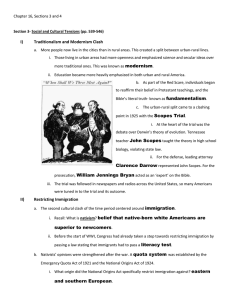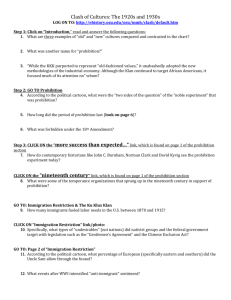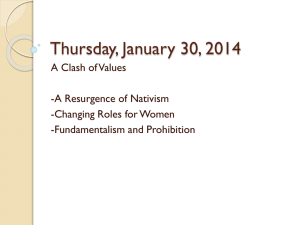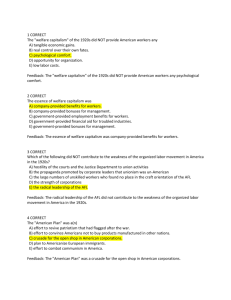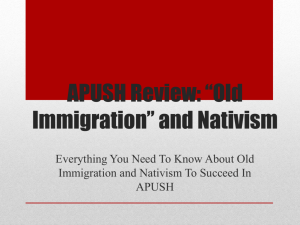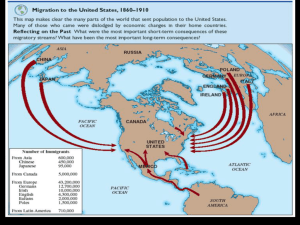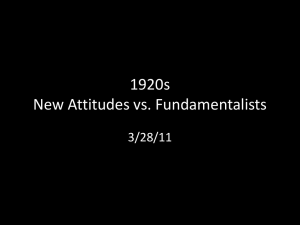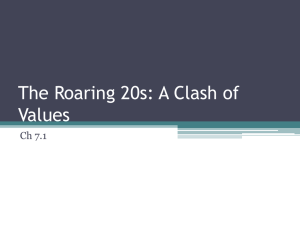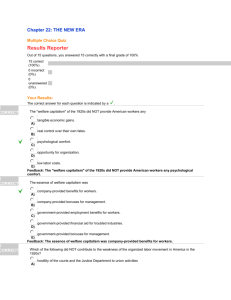AP US History
advertisement
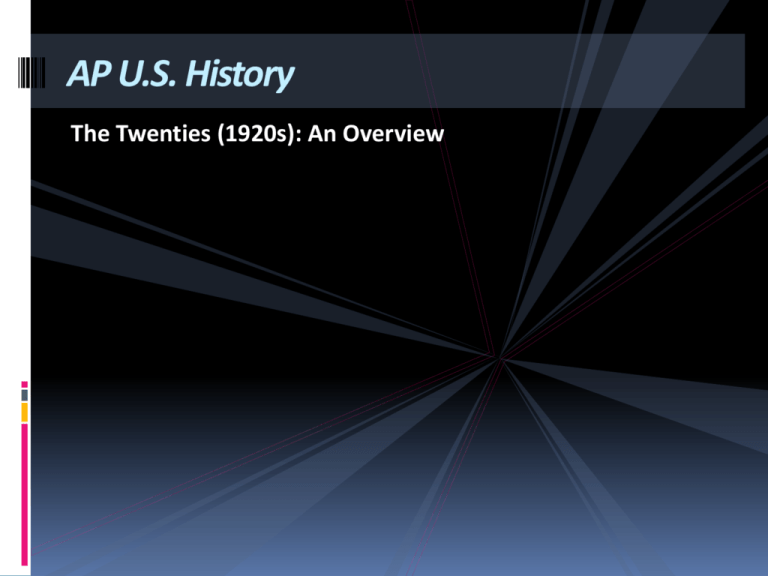
AP U.S. History The Twenties (1920s): An Overview Analyze the origins and outcomes of the intense cultural conflicts of the 1920s. In your response, focus on TWO of the following: Immigration, Prohibition, Religion Immigration Origins Outcomes Southern and eastern European Ku Klux Klan immigration Mexico Ethnic communities, tenements Labor unions feared immigrants, scabs Nativism Immigration restrictions World War I, “100% Americanism” Red Scare, radicalism Anti-Asian attitudes Ku Klux Klan Cultural pluralism (vs. Nativism) Sacco and Vanzetti Emergency Quota Acts of 1921 and 1924 Hispanic immigration Border Patrol established Prohibition Origins Outcomes Temperance Movement, WCTU, Deaths from alcoholism Anti-Saloon League Eighteenth Amendment Volstead Act Prohibition as a “noble experiment” Wets vs. Drys declined Drinking still pervasive, lawbreaking Speakeasies, bootlegging, organized crime 21st Amendment in 1933 Religion Origins Outcomes Modernism vs. Fundamentalism Ku Klux Klan Darwin and evolution Scopes Trial (Darrow and Bryan) Anti-Catholicism and anti- Fundamentalism (argue either Semitism way) Evangelical revivalism How did TWO of the following help shape American national culture in the 1920s: advertising, entertainment, mass production Advertising Glorification of consumption Spending becomes a cultural ideal (rather than thrift), installment buying Consumption becomes a cultural ideal (rather than production) Possession of goods replaces cultural ideals of character and social standing) Impact on women Alters the image of beauty, sells the idea that beauty can be purchased Housewives are now less defined as workers and more defined as consumers Makes sexuality, smoking, and drinking more acceptable for women Changes in the technologies and structures of advertising Focus is on creating dissatisfactions with one’s body, image, and status Preys on insecurities and creates new expectations Cult of celebrity enhanced by use of celebrity endorsements Search for markets Brand names, movement to national markets for brand goods, efforts to create brand loyalties Advertising companies multiply Bruce Barton’s The Man Nobody Knows describes Jesus as a master salesman Entertainment Impacts of movies, radio, phonograph, jazz music Media influences national trends, new ways to spend leisure time, changes the image of women, emphasis on culture of consumption, promotes the cult of celebrity Postwar cynicism of the Lost Generation and other writers F. Scott Fitzgerald, Ernest Hemingway, Gertrude Stein, Sinclair Lewis, H.L. Mencken Mass Production More affordable consumer products Mass distribution accelerates the push for single markets Middle class salaries increase, prices fall Auto production stimulates other industries Impact on workers (further deskilling, declining union membership, declining need for cheap immigrant labor) Large-scale, industrialized agriculture influences availability of goods Labor-saving devices = more time for leisure Businessmen are now celebrities, big business is a cultural icon (unlike during the Gilded Age) Taylorism Describe and account for the rise of nativism in American society from 1900-1930. Nativism: 1900-1930 “New Immigrants” from southern and eastern Europe (Catholics, Jews, Eastern Orthodox) Job competition: immigrants willing to work for lower wages, used as “scab” labor Poor working conditions of immigrants Fear of communism, socialism, and anarchy in labor unions Social Darwinism Chinese Exclusion Act Gentlemen’s Agreement of 1907 Anti-German sentiment during and after WWI Red Scare, Palmer Raids, Sacco and Vanzetti Ethnocentrism Tie between support for Prohibition and anti-foreign sentiment Analyze the primary causes of the population shift from a rural to an urban environment in the United States between 1875 and 1925. Analyze the primary causes of the population shift from a rural to an urban environment in the United States between 1875 and 1925. Rapid expansion of steam railroad network Appearance and widespread use of electric trolleys Attractions of urban culture; the “pull of the city,” including Horatio Alger stories Drought: Great Plains, 1890s-1910s Development and expansion of automobiles Increased agricultural mechanization and improved agricultural productivity Job opportunities in North industrial centers (WWI)
